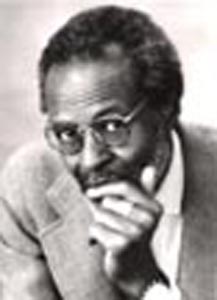 This Goodly Land
This Goodly Land
James Haskins (September 19, 1941–July 6, 2005)

Other Names Used
- James S. Haskins: full name
- Jim Haskins: pen name
Alabama Connections
- Demopolis, Marengo County: birthplace, childhood residence
- Montgomery, Montgomery County: education
Selected Works
- Haskins, James. Diary of a Harlem Schoolteacher. New York: Grove Press, 1969. Rpt. New York: New Press, 2008.
- Haskins, Jim. The Cotton Club. New York: Random House, 1977. Rpt. New York: New American Library, 1984. Rpt. New York: Hippocrene Books, 1994.
- Haskins, James. Black Music in America. New York: T. Y. Crowell, 1987. For younger readers.
- Haskins, Jim. Outward Dreams: Black Inventors and Their Inventions. New York: Walker, 1991. For younger readers.
- Haskins, James. The March on Washington. New York: HarperCollins, 1993. For younger readers.
- Haskins, Jim. Black Eagles: African Americans in Aviation. New York: Scholastic, Inc., 1995. For younger readers.
- Haskins, Jim, and Kathleen Benson. John Lewis in the Lead: A Story of the Civil Rights Movement. Illus. Benny Andrews. New York: Lee & Low, 2006. For younger readers.
- Haskins, James, and Kathleen Benson. Africa: A Look Back. New York: Marshall Cavendish Benchmark, 2007. For younger readers.
- Haskins, Jim, and Kathleen Benson. African American Religious Leaders. Hoboken, N.J.: J. Wiley & Sons, 2008. For younger readers.
Literary Awards
- Coretta Scott King Award, American Library Association, 1977, for The Story of Stevie Wonder
- Carter G. Woodson Book Award, National Council for the Social Studies, 1988, for Black Music in America: A History Through Its People
- Alabama Author Award, Alabama Library Association, 1988, for the Count Your Way series
- Carter G. Woodson Book Award, National Council for the Social Studies, 1994, for The March on Washington
- Washington Post-Children’s Book Guild Nonfiction Award, 1994
- Carter G. Woodson Book Award, National Council for the Social Studies, 1997, for The Harlem Renaissance
Biographical Information
When James Haskins was born in Demopolis, Ala., public schools and facilities were segregated. Because he was black, he couldn’t check books out from the public library, so his mother bought him a supermarket encyclopedia one volume at a time. Later, a white woman who knew his mother checked out books for him. When Haskins was a teen, his parents separated, and he moved with his mother to Boston, where he was admitted to the highly competitive Boston Latin School. He did well there but decided to return to Alabama for college. Haskins was admitted to Alabama State University but was expelled for his participation in the civil rights movement. He then attended Georgetown University, earning a BA in psychology in 1960. He returned to Alabama State, earning a BS in history in 1962, and then went on to the University of New Mexico, where he earned an MA in social psychology in 1963.
Haskins worked briefly in New York City as a stock trader but felt unfulfilled. He began teaching at a public school in Harlem in 1966. He kept a journal of his experiences, creating from it the book Diary of a Harlem School Teacher, published in 1969. He was then approached to write books for younger readers. His first book for children, Resistance: Profiles in Nonviolence, was published in 1970. He eventually wrote over one hundred nonfiction books, for both younger readers and adults, and won many awards. However, Haskins considered himself a teacher first and a writer second. From 1970 to 1977, he taught at the Staten Island Community College of the City University of New York. From 1977 until his death in 2005, Haskins was a professor of English at the University of Florida, Gainesville.
Interests and Themes
Most of James Haskins’s books are either biographies of famous black Americans or are about aspects of black American culture. The Count Your Way series focuses on contemporary cultures in other countries. Haskins wanted to ensure the inclusion of black Americans and other ethnic Americans in the larger fabric of American history and culture.
For More Information
Please check your local library for these materials. If items are not available locally, your librarian can help you borrow them through the InterLibrary Loan program. Your librarian can also help you find other information about this author.
There may be more information available through the databases in the Alabama Virtual Library. If you are an Alabama citizen, AVL can be used at your public library or school library media center. You can also get a username and password from your librarian to use AVL at home.
Reference Book Chapters and Encyclopedia Entries
- "Haskins, James S. 1941-"; Something About the Author. Vol. 132. Detroit: Thomson-Gale, . 84-90.
- "Haskins, James S. 1941- Autobiography Feature"; Something About the Author. Vol. 132. Detroit: Thomson-Gale, . 91-101.
- Haskins, James. "The Humanistic Black Heritage of Alabama"; The Remembered Gate: Memoirs by Alabama Authors. Ed. Jay Lamar and Jeanie Thompson. Tuscaloosa: University of Alabama Press, . 53-60.
- Haskins, James. "The Triumph of the Spirit in Nonfiction for Black Children"; Triumphs of the Spirit in Children's Literature. Ed. Francelia Butler and Richard Rotert. Hamden, Conn.: Library Professional Publications, . 88-96.
Photo by Bill Horne; courtesy of the Caroline Marshall Draughon Center for the Arts & Humanities in the College of Liberal Arts, Auburn University.
Last updated on May 30, 2008.